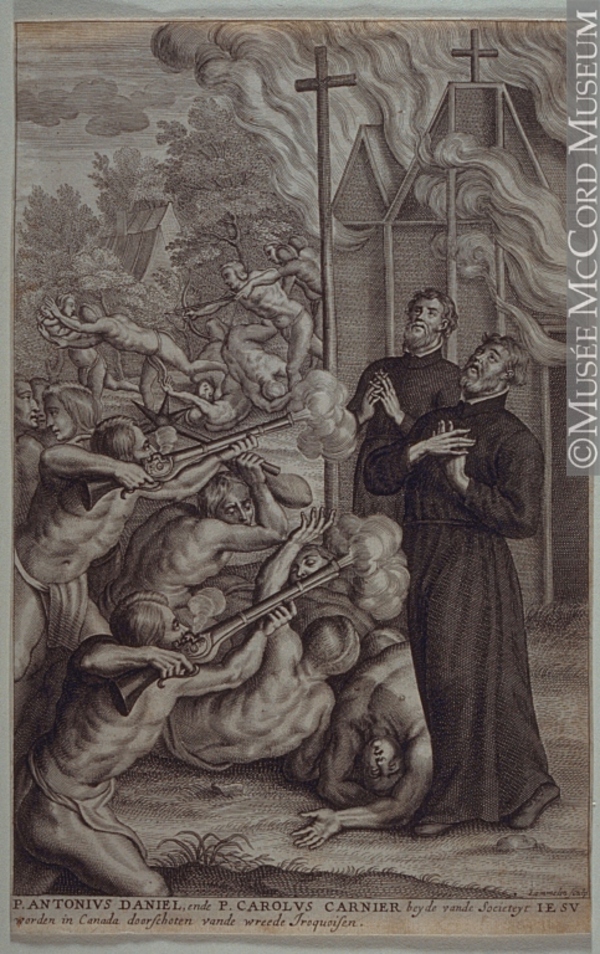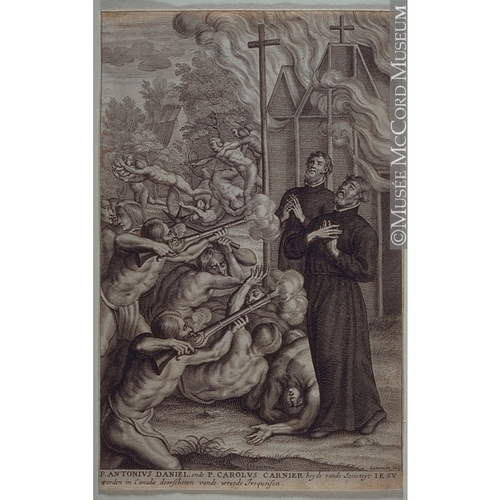
Source: Link
DANIEL, ANTOINE, priest, Jesuit, missionary to the Hurons; canonized by Pope Pius XI on 29 June 1930; b. 27 May 1601 at Dieppe; killed 4 July 1648 in Huronia.
Antoine Daniel had already begun his legal studies when he entered the noviciate of the Society of Jesus at Rouen on 1 Oct. 1621. He was a teacher of junior classes at the Collège in Rouen (1623–27), studied theology at the Collège in Clermont (1627–30), taught humanities (1630–1631), and was minister at the Collège in Eu (1631–32). On 1 Aug. 1626 Father Charles Lalemant wrote from Quebec to his brother Jérôme: “A little Huron is going to see you; he longs to see France. He is very fond of us and manifests a strong desire to be instructed; nevertheless, his father and the Captain of the nation wishes to see him next year, assuring us that, if he is satisfied, he will give him to us for some years. It is of importance that he should be thoroughly satis fied, for if this child is once instructed, it will open the way to many tribes where he will be very useful.” Amantacha dit Louis de Sainte-Foi, was baptized at Rouen during the time that Father Daniel was a teacher at the college. Certain historians have asserted that Father Daniel had prepared Amantacha for baptism; this affirmation has not been completely proved. But the presence of the young Huron at Rouen did not escape Daniel’s notice, and it may be that it played some part in his missionary vocation.
In 1632 Father Daniel arrived at Cape Breton, where the habitation was under the command of his brother, Capt. Charles Daniel. The following year, on 24 June 1633, he was at Quebec and was assigned, with Jean de Brébeuf, to the Huron mission, but their departure did not take place until 1634. No missionary experienced the hardships and perils offered at that period by the trip into Huronia as much as Father Daniel did; in 1634, and again in 1638, he was abandoned on the way by his guides; he soon found himself not only alone but ill, and he attributed to special divine protection the fact that he was able to reach his destination at all. The return trip he made in 1636 was equally arduous, and when he arrived at Trois-Rivières he was literally exhausted.
He made rapid progress in learning the language, and he had soon taught the children to sing the Pater and the Credo in Huron. His kindness, his gentleness, and his gifts as a teacher caused him to be assigned to a new apostolate that the missionaries, in their lack of experience of the actual circumstances, thought both feasible and full of promise for the propagation of the faith: the founding at Quebec of a seminary to which young Hurons would come to be trained in Christian knowledge and virtues. So great were the hopes aroused by this foundation that Huronia sacrificed for it one of its best missionaries, and the Jesuits at Quebec deprived themselves of the services of five very useful servants. Two years’ experience was to show that the children of Huronia were not suited to, and not suitable for, this European type of education. The splendid dream came to naught, and brought about Father Daniel’s return to active missionary life. He devoted himself to it indefatigably and effectively for ten years. On 4 July 1648 the Iroquois overran the Saint-Joseph II mission (Teanaostaiaë, near Hillsdale, Simcoe County, Ontario) just as Father Daniel was finishing his mass. He encouraged the neophytes and spoke so movingly of the truths of the faith that the pagans in large numbers asked him to baptize them. After wreaking havoc in the village, the Iroquois attacked the chapel: “Flee,” said the missionary to his congregation, “and keep the faith to your dying breath.” As for himself, his life belonged to the souls in his charge. He left the chapel and strode towards the enemy, who were astonished by such courage. When the first moment of stupefaction had passed, his body was riddled with arrows. A bullet struck him in the chest, passing through his body, and he fell uttering the name of Jesus. After desecrating his body, the Iroquois threw it into the fire that was consuming the chapel. As the first martyr of Huronia, Father Daniel, even after his death, inspired in his brother missionaries a wealth of tenderness and encouragement. The Relation for 1649 has preserved two instances of this for us.
The Hurons had given Father Daniel the name of Anȣennen.
ACSM, “Mémoires touchant la mort et les vertus des pères Isaac Jogues . . .” (Ragueneau), repr. APQ Rapport, 1924–25, 3, 51. JR (Thwaites), in particular the Relation of 1649 (XXXIV, 86–96) et passim. Positio causae. Campbell, Pioneer priests, II, 197–244. Lucien Campeau, in Lettres du Bas-Canada, II (1948), gives a critical study of the three accounts of the death of Father Daniel that have come down to us. Much the best study is by Fernand Potvin, “Saint Antoine Daniel, martyr canadien,” RHAF, VIII (1954–55), 395–414, 556–64; IX (1955–56), 74–92, 236–49, 392–409 562–70; X (1956–57), 77–92, 252–56. Rochemonteix, Les Jésuites et la Nouvelle-France au XVIIe siècle, II, 74.
Cite This Article
Léon Pouliot, “DANIEL, ANTOINE,” in Dictionary of Canadian Biography, vol. 1, University of Toronto/Université Laval, 2003–, accessed December 17, 2025, https://www.biographi.ca/en/bio/daniel_antoine_1E.html.
The citation above shows the format for footnotes and endnotes according to the Chicago manual of style (16th edition). Information to be used in other citation formats:
| Permalink: | https://www.biographi.ca/en/bio/daniel_antoine_1E.html |
| Author of Article: | Léon Pouliot |
| Title of Article: | DANIEL, ANTOINE |
| Publication Name: | Dictionary of Canadian Biography, vol. 1 |
| Publisher: | University of Toronto/Université Laval |
| Year of publication: | 1966 |
| Year of revision: | 1979 |
| Access Date: | December 17, 2025 |



